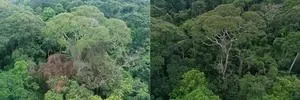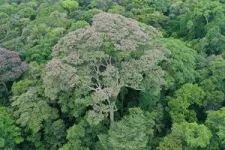(Press-News.org) Getting zapped with millions of volts of electricity may not sound like a healthy activity, but for some trees, it is. A new study, published in New Phytologist, reports that some tropical tree species are not only able to tolerate lightning strikes, but benefit from them. The trees may have even evolved to act as lightning rods.
The research was led by Evan Gora, a forest ecologist at Cary Institute of Ecosystem Studies. Gora studies how lightning impacts biodiversity and carbon storage in Panama’s tropical forests.
Lightning kills hundreds of millions of trees per year. But in 2015, while working in Panama, Gora and his colleagues came across a Dipteryx oleifera tree that had survived a strike with little damage — even though the jolt had been strong enough to blast a parasitic vine out of its crown and kill more than a dozen neighboring trees.
“Seeing that there are trees that get struck by lightning and they’re fine was just mind-blowing,” Gora recalled. Over time, the team encountered other Dipteryx oleifera trees thriving after getting hit, so they decided to take a closer look.
Scientists had previously suspected that some trees evolved to tolerate lightning, but evidence to back it up was lacking. In 2022, Gora and colleagues demonstrated for the first time that trees differ in their ability to survive getting hit by lightning. Their new paper, published Wednesday, is the first to show that trees can benefit from these electric jolts.
Using a unique lightning location system, the team tracked the outcomes of 93 trees that had been struck by lightning in Barro Colorado Nature Monument in central Panama. For two to six years after the strike, the team measured tree survival rates, crown and trunk condition, number of parasitic vines or lianas, and neighboring tree mortality. The study included nine directly struck Dipteryx oleifera trees, and compared them with 84 other trees that had been struck.
All nine Dipteryx trees survived direct lightning strikes with only minor damages. In contrast, directly struck trees of other species were badly damaged, losing 5.7 times more leaves from their crowns, and 64% died within two years.
When each Dipteryx tree was zapped, an average of 9.2 neighboring trees were killed as the electricity traveled between adjoining vines and touching branches, or jumped across small gaps between trees. Lightning strikes also reduced Dipteryx liana infestations by 78%, freeing trees from some of the pressure these parasitic vines have on light and nutrient availability.
These patterns also bore out across the broader population. The team found that Dipteryx trees tend to have fewer lianas. Analyzing trends in tree death over the past 40 years, the researchers found that the trees neighboring Dipteryx trees were 48% more apt to die than other trees in the forest, likely because of lightning.
Using drones, Gora and colleagues created 3D models of canopy height, which showed that Dipteryx trees tend to be about four meters taller than their nearest neighbors, likely because lightning killed their taller neighbors, giving them an advantage in competing for light and space.
“These data provide the first evidence that some trees benefit from being struck by lightning,” the authors write. Or, as Gora puts it, “It's better off for a Dipteryx oleifera tree to be struck than not.”
Because of all these benefits, Dipteryx oleifera trees may be specially adapted to attract lightning. With their distinctive height and unusually wide crowns, they may be up to 68% more likely to get electrocuted than other trees with average height and crowns, according to the team’s calculations.
Estimates suggest individual Dipteryx oleifera trees are directly hit by lightning every 56 years, on average. And since the trees can live for hundreds or possibly more than a thousand years, they are expected to survive these blasts many times throughout their lives. During the study, one of the Dipteryx trees was struck twice in just five years.
The remarkable ability to survive lightning strikes and benefit from the removal of lianas and competitors gives Dipteryx trees a major advantage over other trees. According to the scientists' calculations, lightning tolerance boosts the species’ ability to produce offspring by 14 times.
Next, the team aims to investigate what electrical or structural traits allow these trees to survive lightning strikes. They would also like to explore whether other species show lightning tolerance, to better understand how common this phenomenon is.
What is clear is that lightning plays an underappreciated role in tree competition. And with lightning on the rise in many regions due to climate change, its influence may increase, potentially favoring lightning-tolerant species like Dipteryx oleifera. Understanding lightning and its role in shaping forests may be important for predicting changes in biodiversity and carbon storage, and for informing tropical reforestation efforts.
xx
Study co-authors include: Helene Muller-Landau and Pablo Narváez of the Smithsonian Tropical Research Institute; KC Cushman of Oak Ridge National Laboratory; Jeannine Richards of Florida Gulf Coast University; Phillip Bitzer and Jeffrey Burchfield of the University of Alabama in Huntsville; and Stephen Yanoviak of the University of Louisville.
This work was supported by grants from the National Science Foundation (DEB-1354060, DEB-1655346, and DEB-2213246 to SPY, DEB-1354510, DEB-1655554, and DEB-2213247 to PMB, and DEB-2213245, DEB-2241507, and GRF-2015188266 to EMG), the National Geographic Society (9703-15 to EMG), and a Smithsonian Tropical Research Institute Tupper Postdoctoral Fellowship to EMG. KCC was supported as part of the Next Generation Ecosystem Experiments-Tropics, funded by the U.S. Department of Energy, Office of Science, Office of Biological and Environmental Research.
xx
Cary Institute of Ecosystem Studies is an independent nonprofit center for environmental research. Since 1983, our scientists have been investigating the complex interactions that govern the natural world and the impacts of climate change on these systems. Our findings lead to more effective resource management, policy actions, and environmental literacy. Staff are global experts in the ecology of: cities, disease, forests, soils, and freshwater.
New Phytologist is a leading international journal focusing on high quality, original research across the broad spectrum of plant sciences, from intracellular processes through to global environmental change. The journal is owned by the New Phytologist Foundation, a not-for-profit organisation dedicated to the promotion of plant science.
END
Getting hit by lightning is good for some tropical trees
Cary-led study reveals lightning benefits some trees by killing off parasitic vines and opening up the canopy
2025-03-26
ELSE PRESS RELEASES FROM THIS DATE:
Soldiers can cope with killing
2025-03-26
Taking a person’s life is not automatically harmful to a soldier’s mental well-being if the circumstances justified it, according to a study of more than 14,600 soldiers.
“Killing another person does not in itself seem to be something that goes against human nature, and it doesn’t necessarily harm the mental health of the person who does it,” said Andreas Espetvedt Nordstrand, a Norwegian clinical psychologist.
Commander Nordstrand is the head of research and development at the Institute of Military Psychiatry, Norwegian Armed Forces – Joint ...
Quantum Leap: NIST selects FAU for new generation of encryption standards
2025-03-26
The National Institute of Standards and Technology (NIST) has selected Florida Atlantic University’s Hamming Quasi-Cyclic (HQC) for standardization in its Post-Quantum Cryptography (PQC) project. After a thorough evaluation process, NIST selected HQC to be part of the new generation of encryption standards, for its ability to meet its criteria for security, efficiency and practical implementation.
HQC is a cryptographic algorithm designed to ensure secure key exchange between two parties, enabling ...
City of Hope-led study demystifies tumor formation’s two-step process — a foundational understanding needed to prevent cancer
2025-03-26
LOS ANGELES — Researchers at City of Hope®, one of the largest and most advanced cancer research and treatment organizations in the U.S. with its National Medical Center named top 5 in the nation for cancer by U.S. News & World Report, have found that cell mutations are necessary but not always sufficient for tumors to form. Instead, they suggest that additional risk factors that promote tumor growth, like chronic inflammation, are a key trigger for tumor formation.
The study findings, published this month in Cancer Discovery, answer a question that scientists have long asked: Are cell mutations alone ...
We are vastly overestimating the amount of fresh water available for lithium mining, new study finds
2025-03-26
March 26, 2025
We Are Vastly Overestimating the Amount of Fresh Water Available for Lithium Mining, New Study Finds
New research led by UMass Amherst hydrologists sounds the alarm over mining practices that have immediate implications for transition to low-carbon economy
AMHERST, Mass. — New research into lithium mining in the “Lithium Triangle” of Chile, Argentina and Bolivia — source of more than half of the world’s lithium resources — shows that the commonly accepted models used ...
If native plants are going to survive climate change, they need our help to move—here’s how to do it safely
2025-03-26
March 26, 2025
AMHERST, Mass. – Many native plants in the U.S. cannot possibly move themselves fast enough to avoid climate-change driven extinction. If these native plants are going to have any chance of surviving into the future, they’ll need human help to move into adjacent areas, a process known as “managed relocation.” And yet, there’s no guarantee that a plant will thrive in a new area. Furthermore, movement of introduced plants, albeit over much larger distances, is exactly how the problem of invasive species began—think of kudzu-choked forests, wetlands taken over by purple ...
Blue pigment improves foundation makeup shades for dark skin
2025-03-26
SAN DIEGO, March 26, 2025 — On the shelves of makeup counters and drugstores sits an array of foundations in various olive, ivory and fair shades. But for people with darker skin tones, finding the right foundation shade can be a challenge. Dark foundations on the market often fall flat, appearing gray-like once applied on the skin. But now, researchers report a blue cosmetic color additive that gives these foundations the warmth and depth they currently lack.
Gabriella Baki, associate professor of pharmaceutics and director of the cosmetic science and formulation design undergraduate program at the University of ...
A safe nuclear battery that could last a lifetime
2025-03-26
SAN DIEGO, March 26, 2025 — Sometimes cell phones die sooner than expected or electric vehicles don’t have enough charge to reach their destination. The rechargeable lithium-ion (Li-ion) batteries in these and other devices typically last hours or days between charging. However, with repeated use, batteries degrade and need to be recharged more frequently. Now, researchers are considering radiocarbon as a source for safe, small and affordable nuclear batteries that could last decades or longer without charging.
Su-Il In, a professor at Daegu Gyeongbuk Institute of Science & Technology, will present his results at the spring meeting of the American Chemical ...
Making sturdy, semi-transparent wood with cheap, natural materials
2025-03-26
SAN DIEGO, March 26, 2025 — Can you imagine a smartphone with a wooden touchscreen? Or a house with wooden windows? Probably not — unless you’ve heard of transparent wood. Made by modifying wood’s natural structure, this material has been proposed as a sturdy, eco-friendly plastic alternative. But wood’s biodegradability is often sacrificed in the process. Researchers are hoping to change that by creating transparent woods from almost entirely natural materials and making them electrically conductive.
The researchers will present their results at the spring ...
Adulting is hard on the heart: Teen to young adulthood is a critical time to address risk
2025-03-26
Statement Highlights:
By age 18, many adolescents have already developed heart disease risk factors, such as high blood pressure, obesity, high cholesterol or Type 2 diabetes, and a growing number of younger adults are experiencing adverse cardiovascular events.
Numerous social determinants of health and developmental and life changes impact cardiovascular risk as young people progress from their teens to their mid-20s.
The statement describes the challenges and opportunities for easing the transition ...
Study shows link between the start of the working day and time preferences
2025-03-26
Those who start work earlier express more discomfort with the seasonal time change. This is the main conclusion of a study that the lecturers at the University of Santiago de Compostela (USC) and the University of Seville (US), Jorge Mira Pérez and José María Martín Olalla, have just published in the journal Chronobiology International, in which they analyse in detail the results of the public consultation organised by the European Commission in 2018 in the then 28 member states, which ...
LAST 30 PRESS RELEASES:
Tracing the quick synthesis of an industrially important catalyst
New software sheds light on cancer’s hidden genetic networks
UT Health San Antonio awarded $3 million in CPRIT grants to bolster cancer research and prevention efforts in South Texas
Third symposium spotlights global challenge of new contaminants in China’s fight against pollution
From straw to soil harmony: International team reveals how biochar supercharges carbon-smart farming
Myeloma: How AI is redrawing the map of cancer care
Manhattan E. Charurat, Ph.D., MHS invested as the Homer and Martha Gudelsky Distinguished Professor in Medicine at the University of Maryland School of Medicine
Insilico Medicine’s Pharma.AI Q4 Winter Launch Recap: Revolutionizing drug discovery with cutting-edge AI innovations, accelerating the path to pharmaceutical superintelligence
Nanoplastics have diet-dependent impacts on digestive system health
Brain neuron death occurs throughout life and increases with age, a natural human protein drug may halt neuron death in Alzheimer’s disease
SPIE and CLP announce the recipients of the 2025 Advanced Photonics Young Innovator Award
Lessons from the Caldor Fire’s Christmas Valley ‘Miracle’
Ant societies rose by trading individual protection for collective power
Research reveals how ancient viral DNA shapes early embryonic development
A molecular gatekeeper that controls protein synthesis
New ‘cloaking device’ concept to shield sensitive tech from magnetic fields
Researchers show impact of mountain building and climate change on alpine biodiversity
Study models the transition from Neanderthals to modern humans in Europe
University of Phoenix College of Doctoral Studies releases white paper on AI-driven skilling to reduce burnout and restore worker autonomy
AIs fail at the game of visual “telephone”
The levers for a sustainable food system
Potential changes in US homelessness by ending federal support for housing first programs
Vulnerability of large language models to prompt injection when providing medical advice
Researchers develop new system for high-energy-density, long-life, multi-electron transfer bromine-based flow batteries
Ending federal support for housing first programs could increase U.S. homelessness by 5% in one year, new JAMA study finds
New research uncovers molecular ‘safety switch’ shielding cancers from immune attack
Bacteria resisting viral infection can still sink carbon to ocean floor
Younger biological age may increase depression risk in older women during COVID-19
Bharat Innovates 2026 National Basecamp Showcases India’s Most Promising Deep-Tech Ventures
Here’s what determines whether your income level rises or falls
[Press-News.org] Getting hit by lightning is good for some tropical treesCary-led study reveals lightning benefits some trees by killing off parasitic vines and opening up the canopy









